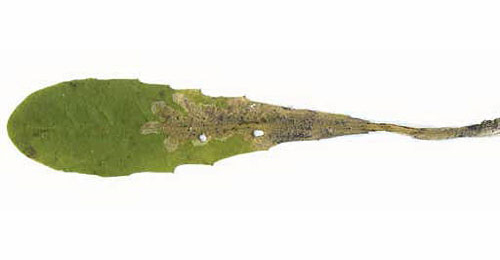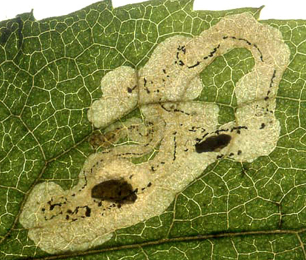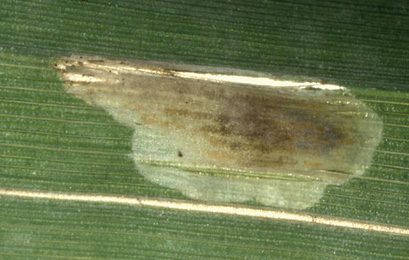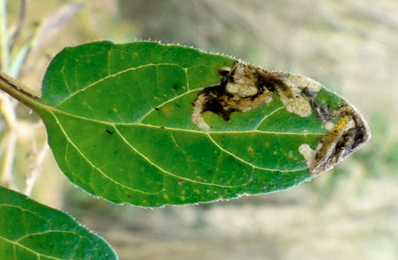|
||||||
|
BELLIS. Daisy. [Asteraceae] |
|
Two species of Bellis are recorded in Britain, the native Daisy (B. perennis) and the introduced B. annua. Thirteen British miners are recorded on Bellis. The polyphagous agromyzid Liriomyza trifolii has been recorded in quarantine in Britain (Pitkin & Plant in British leafminers). See also Liriomyza species in Glasshouses and/or Quarantine Interceptions. Elsewhere the agromyzid Napomyza lateralis is recorded in the stems of Bellis. One non-Diptera leaf-miner, Coleophora ramosella, is recorded on Bellis in Britain. Elsewhere three additional British non-Diptera miners are recorded on Bellis. A key to the European miners recorded on Bellis is provided in Bladmineerders van Europa. |
|
Key for the identification of the known mines of British |
Note: Diptera larvae may live in a corridor mine, a corridor-blotch mine, or a blotch mine, but never in a case, a rolled or folded leaf, a tentiform mine or sandwiched between two more or less circular leaf sections in later instars. Pupation never in a cocoon. All mining Diptera larvae are leg-less maggots without a head capsule (see examples). They never have thoracic or abdominal legs. They do not have chewing mouthparts, although they do have a characteristic cephalo-pharyngeal skeleton (see examples), usually visible internally through the body wall. The larvae lie on their sides within the mine and use their pick-like mouthparts to feed on plant tissue. In some corridor miners frass may lie in two rows on alternate sides of the mine. In order to vacate the mine the fully grown larva cuts an exit slit, which is usually semi-circular (see Liriomyza huidobrensis video). The pupa is formed within the hardened last larval skin or puparium and as a result sheaths enclosing head appendages, wings and legs are not visible externally (see examples). See Key to non-Diptera. |
1a > Leaf-miner: Mine associated primarily with mid-rib. |
1b > Leaf-miner: Mine not primarily associated with mid-rib. |
2a > Leaf-miner: Larvae feeding in basal leaves, mainly in mid-rib, moving from one leaf to another via the base of the leaves. Pupation internal (Spencer, 1972b: 68). Most of the time the larva lives in the midrib of the rosette leaves. Now and then short excursions are made into the blade. At first they are pale green, later they are almost full depth and whitish, and quite conspicuous. They do not contain frass. The larva may migrate from one leaf to another by way of the heart of the rosette. For its development it needs 3-4 leaves. Pupation within the mine. Before that the larva has scraped clean the wall of the puparial chamber up to the cuticula.. |
|
Napomyza bellidis Griffiths, 1967 [Diptera: Agromyzidae]. |
2b > Leaf-miner: A whitish blotch mine along mid-rib, with offshoots into leaf blade. Pupation takes place at the base of the mid-rib (Spencer, 1972b: 25; Spencer. 1976: 63 (fig. 66)). The mine begins as a very narrow, upper- or lower-surface corridor, somewhere in the blade. When this hits a thick vein the larva uses this to descend towards the midrib. From that moment the lave lives in the hollow midrib. From here short, lobate corridors enter the leaf blade. The larva may move to another leaf by way of the leaf base. The corridors in the leaf are virtually free of frass (at most a few grains where they leave the midrib); frass is concentrated in the base of the midrib. Here also the pupation takes place. |
 Mine of Ophiomyia cunctata on Taraxacum officinale Image: © Willem Ellis (Bladmineerders van Europa) |
|
Ophiomyia cunctata (Hendel, 1920) [Diptera: Agromyzidae]. |
2c > Leaf-miner: A distinctive mine primarily above mid-rib, with irregular short lateral offshoots into leaf blade. Pupation external (Spencer, 1972: 51 (fig. 172), 55; Spencer, 1976: 270, 271 (fig. 486)). Branched, whitish, upper-surface corridor; main axis overlying the midrib; side branches overlying the main lateral veins. (In Campanula and Phyteuma the mine is much less branched, sometimes nothing more than a corridor on top of the midrib). Frass in rather long strings. Usually the mines begins as a long and narrow, shallow, tortuous lower-surface corridor that ends upon the midrib but otherwise is not associated with the leaf venation. Often this initial corridor is filled with callus, and then even less conspicuous. Pupation outside the mine. A linear mine on the upper surface, usually following the midrib and showing side branches along the veins. The frass is in strings. |
|
Liriomyza strigata (Meigen, 1830) [Diptera: Agromyzidae]. |
3a > Leaf-miner: A short linear mine in first instar, later producing a circular or oval blotch. Frass is excreted in a black mass prior to pupation; puparium firmly glued with frass within the mine (Spencer, 1976: 306). Large, whitish, upper-surface blotch, preceded by a short corridor that often is overrun later by the developing blotch. The larva hardly produces any frass; the few grains that are present are black and rather coarse. But when the larva is about to pupate, it empties its intestine, which has the effect that the puparium is anchored in the mine by dried frass. The initial gallery by the first instar larva then leads to a whitish blotch. The puparium is fixed to the inside of the mine by an accumulation of frass. |
|
Calycomyza humeralis (von Roser, 1840) [Diptera: Agromyzidae]. |
3b > Leaf-miner: Mine linear, whitish, both upper and lower surface. Pupation internal, at the end of the mine with the anterior spiracles projecting through the epidermis (Spencer, 1976: 433). Upper-surface, less often lower-surface corridor. Frass in isolated grains. Pupation within the mine, usually in a lower-surface puparial chamber. A long whitish upper surface corridor, which eventually goes lower surface. |
|
Chromatomyia
horticola (Goureau, 1851) [Diptera: Agromyzidae] |
3c > Leaf-miner: A conspicuous white mine with frass in more or less connected strips, older mines can show a conspicuous reddish-violet discolouration (Spencer, 1972b: 76 (fig. 253), 80; Spencer, 1976: 501). Upper surface corridor, 6-9 cm in length, densely wound, easily confluent into a secondary blotch. Frass unusual, in more or less connected strings at either side of the corridor. Pupation outside the mine, exit slit usually in the upper epidermis. According to Hering dried mines turn yellow brown to reddish purple. |
 Mine of Phytomyza solidaginis on Solidago virgaurea Image: © Willem Ellis (Bladmineerders van Europa) |
|
Phytomyza solidaginis Hendel, 1920 [Diptera: Agromyzidae]. |
3d > Leaf-miner: A whitish linear mine, with frass predominantly in separate grains, rather than connected strips (Spencer, 1976: 525). Initially narrow, gradually and weakly widening corridor of about 10-12 cm. The mine is upper-surface, pale green. Feeding lines not conspicuous. Frass in separate grains or short pearl chains. Pupation outside the mine, exit slit in lower epidermis. |
|
Phytomyza virgaureae Hering, 1826 [Diptera: Agromyzidae]. |
3e > Leaf-miner: An irregular linear mine, which in small leaves can form a secondary blotch. Long, upper-surface corridor, winding through the leaf and frequently crossing itself; in small leaves often a secondary blotch in the end. Frass in short strings and pearl chains. Pupation outside the mine. An irregular gallery, sometimes crossing over, with black frass arranged as elongate very narrow streaks at the sides of the mine. |
|
Liriomyza pusilla (Meigen, 1830) [Diptera: Agromyzidae]. |
3f > Leaf-miner: Irregular mine, locally shallow, elsewhere much deeper, giving it a mottled appearance. In broadleaved plants the mine often begins as a blotch with stellate extensions, but sometimes as a very fine, shallow corridor. In grasses the mine often begins in the leaf sheath. The frass is very fine-grained, initially scattered, later in aggregates. The egg is deposited on the plant surface, and the empty egg shell remains visible. But the larvae are able to leave their mine and restart elsewhere, thus mines without an egg shell can be found as well. The larva also leaves the mine before pupation. Pupation takes place in a newly made, small, blotch mine without frass; this mine may be made in another plant (species). |
 Mine of Hydrellia griseola on Glyceria fluitans Image: © Willem Ellis (Bladmineerders van Europa) |
|
Hydrellia griseola (Fallén, 1813) [Diptera: Ephydridae]. |
|
Key for the identification of the known mines of British |
Note: The larvae of mining Coleoptera, Hymenoptera and Lepidoptera may live in a corridor mine, a corridor-blotch mine, a blotch mine, a case, a rolled or folded leaf, a tentiform mine or sandwiched between two more or less circular leaf sections in later instars. Larva may pupate in a silk cocoon. The larva may have six legs (although they may be reduced or absent), a head capsule and chewing mouthparts with opposable mandibles (see video of a gracillarid larva feeding). Larvae of Hymenoptera and Lepidoptera usually also have abdominal legs (see examples). Frass, if present, never in two rows. Unless feeding externally from within a case the larva usually vacates the mine by chewing an exit hole. Pupa with visible head appendages, wings and legs which lie in sheaths (see examples). |
1a > Leaf-miner and case-bearer: The larva lives outside the mine, protected by a case, and feeds on the underlying plant tissues via a hole cut in the epidermis. From that point it eats away as much leaf tissue as it can reach without fully entering the mine. Mine does not contain frass. Tubular silk case, about 9 mm long, trivalved, with a mouth angle of about 20°. (Coleophora species) |
|
Coleophora ramosella Zeller, 1849 [Lepidoptera: Coleophoridae]. |
1b > Leaf-miner but not a case-bearer |
| 2 |
2a > Leaf-miner: Rather long full depth corridor that winds freely through the leaf and may cross itself. In the end the corridor widens considerably. Frass mostly in a narrow central line, but may also be deposited along the sides or be missing. The larvae regular leave a mine to restart elsewhere. Pupation outside the mine. Neither larva or mine can be distinguished from that of related species. |
|
Apteropeda orbiculata (Marsham, 1802) [Coleoptera: Chrysomelidae]. |
2b > Leaf-miner: In the first instar the larva mines the leaves, forming short, irregular, blotch-like mines, but in later instars it lives externally, feeding in spun leaves and often twisting those of tender shoots. Larval head light-brown or yellowish brown, edged with black postero-laterally, ocellar area blackish; prothoracic plate black edged with whitish anteriorly; abdomen dull dark green; pinacula distinct, black, sometimes brownish but with black bases to setae; anal plate large, black (Bradley et al., 1973). Small, full depth mine without a definite shape; little frass. Some silk is deposited in the mine. The larva soon leaves the mine and continues feeding among spun leaves. |
|
Cnephasia incertana (Treitschke, 1835) [Lepidoptera: Tortricidae]. |
2c > Leaf-miner: Rather narrow corridor, untidy and sometimes branched, starting from the base of the leaf, in particular the midrib. Sides of the corridor irregularly eaten out, not really parallel. Frass mostly present, and then in a central line. The larva is capable of leaving the mine and start a new one elsewhere. These later mines are much broader, and the frass is scattered irregularly.. |
 Mine of Orthochaetes insignis on Prunella vulgaris Image: © Jean-Yves Baugnée (Bladmineerders van Europa) |
| Host plants unknown in Britain. On numerous genera and species in several plant families, including Bellis, elsewhere. Recorded in southern England. Widespread in continental Europe. |
Orthochaetes insignis (Aube, 1863) [Coleoptera: Curculionidae]. |
| Last updated 01-Jul-2019 Brian Pitkin | ||

